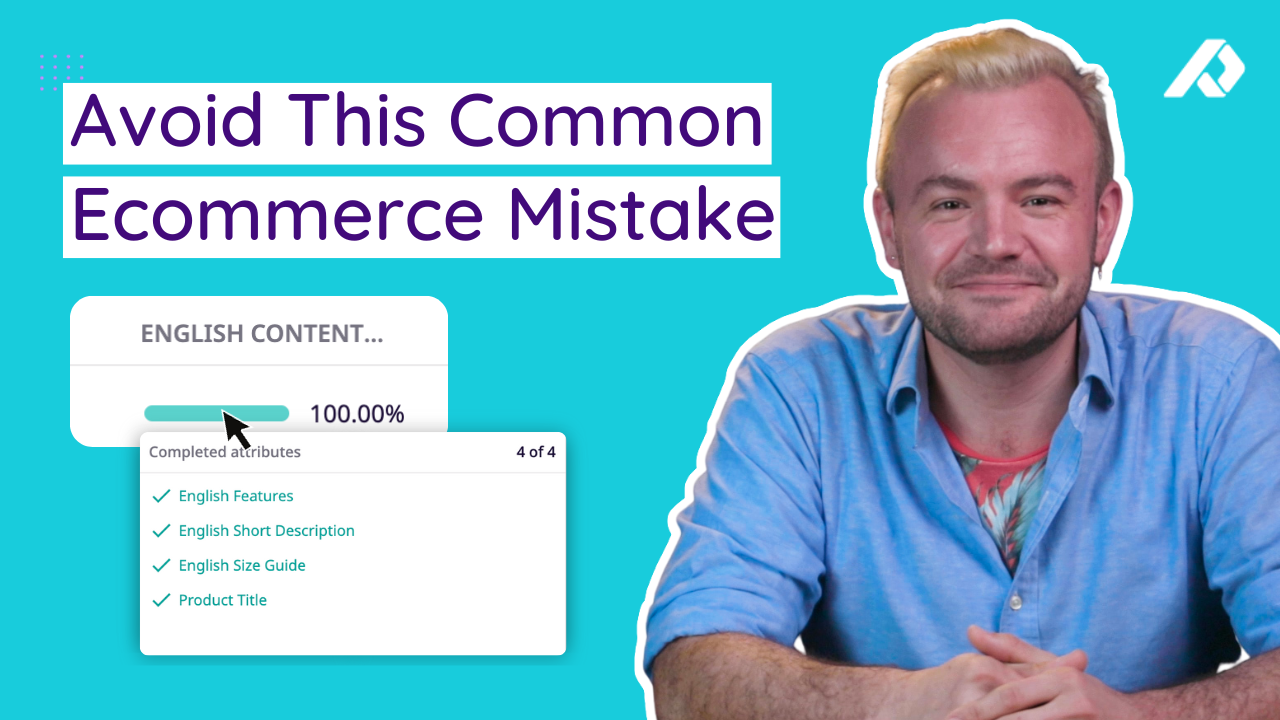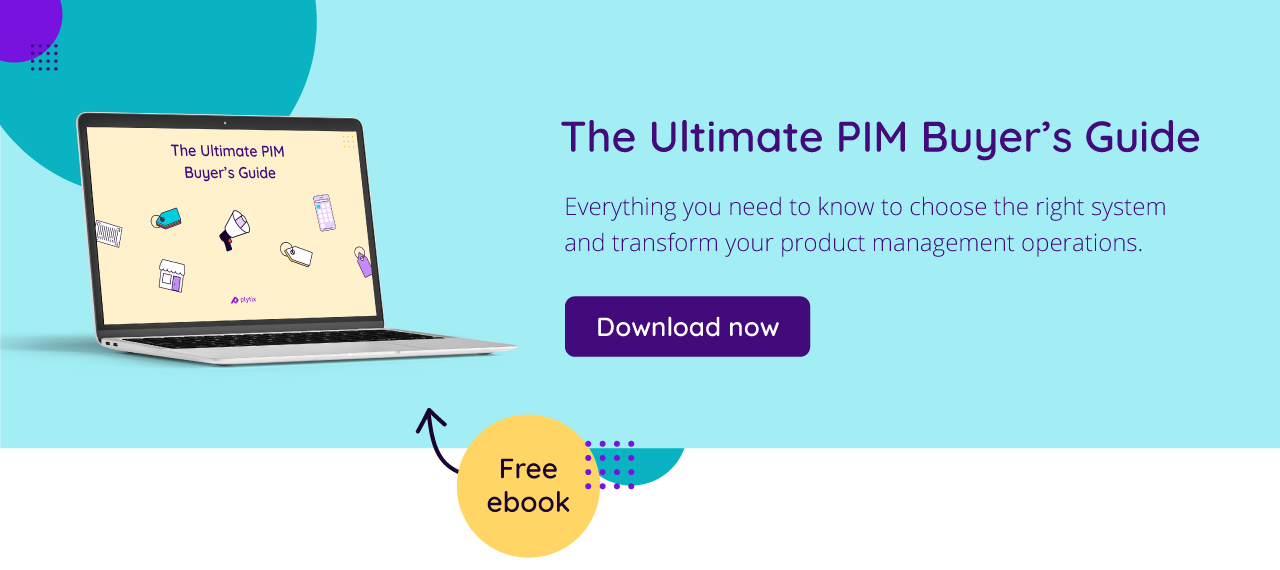
Keep the good stuff coming
Subscribe to our blog newsletter and get monthly content that helps you manage product data smarter.
No spam. Just real value.
70% of online shoppers say product content can make or break a sale, according to Forbes. But if you’re the retailer responsible for all that product information and multimedia, what’s the best way to manage it?
Without specialized software to help, ecommerce managers can end up storing their product data in multiple spreadsheets, keeping their product photos, videos, and other assets in a bunch of different folders and drives, and generally having everything scattered across far too many different systems. It’s not the most efficient way to do things and can quickly lead to data inconsistencies and inaccuracies, as well as workers having to spend far too much time on manual processes and tasks.

That’s why every year, more and more people in retail use Product Information Management or PIM software to manage their data, since it’s designed to store, organize, and oversee product information. It’s a useful tool, but understanding this tech can be complicated when you’re first getting started. For that reason, we’ve put together this beginner’s guide to PIM software to take you through what a PIM tool does, how it can benefit retailers, what data it works with, and what retail processes it can help automate.
What PIM software does: the four key points
Before we get into the more advanced aspects of PIM software for retail, it’s important to understand the four main functions of any PIM tool. You can use PIM software to:
- Get all your product information and multimedia in one place,
- Make sure everything is accurate and up-to-date,
- Adapt that data for each of your various retail platforms and marketplaces, and then
- Send those different sales channels all the data and media they need, as efficiently as possible.
How does PIM software benefit retailers?
PIM software can be useful for retailers of any size and nature, but the benefits really start to become apparent once your catalog grows to a certain size or you start to work with multiple suppliers or retail partners—here’s why.
Work from one central system
Firstly, PIM software provides retailers with a single source of truth for product data and product assets. In case you’re unfamiliar with this concept, it’s basically the idea of getting all of your data into one system so that everyone who needs it can access it whenever necessary. This isn’t just on an internal level either—PIM tools give you the option to give your suppliers and retail partners direct access too, so they can upload or download whatever data they need without you having to get involved (unless you want to).
Control access levels and activity
Security is a key factor when giving more people access to your data, especially if you’re including people from outside your organization, which is why with PIM software you can also adjust permission levels depending on the user. That way, only the people you choose have the ability to edit or view your data. Detailed activity logs also allow you to see who’s done what and when.
Check all your retail data at once
Centralization is vital in retail since it gives you an immediate overview of all your product data and digital assets, a.k.a. your images, videos, and other files. This means you can quickly and easily make sure that you have is up-to-date, accurate, and consistent product information everywhere that you sell, whether that’s on your website, in your catalog, on a third-party marketplace, or on any other sales channel.
 Keep your customers happy
Keep your customers happy
This attention to detail matters—after all, nearly 90% of consumers would be unlikely or very unlikely to make a repeat purchase from a retailer after coming into contact with inaccurate product information. For that reason, using PIM software to reduce the risk of customer confusion or dissatisfaction can directly impact sales and your brand’s reputation.
Quickly filter your products
Using a PIM tool to store and build your retail catalog can save you a massive amount of time when browsing your products as well, thanks to advanced search features. Imagine you’re a clothes retailer, for example, and you want to check a particular detail about just the womenswear items that you’ve added to your catalog in the last six months that also contain a certain material—maybe you want to check that the word “cashmere” is or isn’t capitalized in this case. The search functionality in PIM software gives you a quick way to simultaneously apply multiple filters, so in this case by category, date created, and keywords. The result? The ability to see just the relevant items in seconds and start working on them ASAP.
Get your information where it needs to be
Finally, PIM software can help you speed up your data distribution process. For some retail platforms or marketplaces, your PIM tool can create one downloadable file containing all your required data and assets that you can then transfer over to the sales channel yourself. Better yet, for others it can generate a link that lets the channel fetch the data itself on a scheduled basis. In some even more convenient cases, the PIM software even has a direct integration with the retail platform in question, like Plytix’s integration with Shopify.
What data can PIM software manage?
PIM tools can process all sorts of product information, including:
- Essential product data (e.g. SKUs, product titles, descriptions)
- Technical specifications (e.g. measurements, materials, weights)
- Taxonomy (e.g. categories, variations, relationships)
- Marketing material (e.g. SEO content, product catalogs, testimonials)
- Localized content for different channels and marketplaces (e.g. translations, prices in multiple currencies, attributes only required by specific platforms)
Many PIM tools also include Digital Asset Management functionality, which lets you store your product photos, video, and any other files in the same system as your product data. As mentioned earlier, this integration can save a lot of time and effort since it stops you from having to constantly jump between different systems when updating details about your products.
What retail processes can PIM software automate?
PIM software also has some more high-tech features that allow you to automate a number of manual data-related tasks and processes—here’s a selection of PIM features that can really help you up your retail game.
Generating smart lists
By saving the search criteria or filters we mentioned earlier, you can get your PIM tool to generate smart lists for whatever purpose you want. What’s useful here (and different from a regular product list) is that these lists will update themselves automatically whenever you add, remove, or update products in your catalog. This way, these lists will always contain whichever products match the criteria you’ve set at any given moment, with no extra work on your part.
 Completeness tracking
Completeness tracking
PIM software also has features to help you automatically monitor how complete or incomplete your product data is too, such as the aptly-named completeness attributes in Plytix PIM. These show how much information has been completed for the product in question based on a list of other attributes that you select—say, all the data points necessary to list a product on Google Marketplace—and often take the form of a progress bar.
Automated workflows based on readiness
Use completeness attributes as the basis for smart lists, and you can create automated workflows for a variety of purposes. Combining these features means you can get your PIM tool to generate lists that automatically update themselves to include only products that are or aren’t ready for particular purposes—and you can learn more about that process in the following video.

Adapting data and images for different channels
Another automation feature that saves a lot of time is adapting your product information and multimedia for different sales channels based on each channel's particular requirements. The important detail here though is that you can do this without having to take up space in your system with multiple versions of the same data or assets. PIM software does this by taking your original information or image and transforming 
That way, your sales channel receives the data or asset in the form that it needs, but the version in your PIM tool stays the same. This lets you use one original version for multiple channels and purposes (instead of filling your system with a load of unnecessary duplicates).
Learn more about PIM
Efficiency is crucial in retail, and having the right software in place can make all the difference. For more information about how PIM software could benefit your company, check out our PIM buyer’s guide linked down below—it’s full of practical PIM tips and data, along with a comparison of the top PIM software providers currently on the scene.
And if you’re interested in learning more about Plytix in particular, then book a demo! We’re always happy to show people everything this powerful software can do.
Frequently Asked Questions
In retail, PIM (or Product Information Management) is a kind of software designed to allow retailers to gather, manage, and distribute their product information and digital assets from a single platform. PIM software centralizes product data, ensuring it's accurate, consistent, and easily accessible for various sales channels. This not only streamlines the management of product information but also significantly improves the shopping experience for customers by providing them with up-to-date and reliable product data.
PIM stands for Product Information Management. It refers to software tools that help retailers and ecommerce managers keep track of all their product data in one place. These tools are designed to simplify the process of storing, organizing, and updating product information, including descriptions, specifications, images, and videos. The goal of PIM is to improve efficiency, reduce the risk of errors, and enhance the presentation of products across different sales channels.
PIM software is a must-have for retailers of any size looking to optimize their online presence and sales. It's particularly beneficial for businesses experiencing growth in their catalog size, those dealing with a wide range of products, or companies working with multiple suppliers and retail partners. If you find yourself juggling product data across various spreadsheets and storage solutions, or if keeping your product information consistent and up-to-date across multiple sales channels is becoming a challenge, then PIM is for you. It's a scalable solution that can adapt to the needs of small businesses as well as large enterprises.
A PIM strategy involves the planned approach and practices a retailer adopts to manage their product information using PIM software. It's about more than just implementing the tool; it's about how you use it to streamline operations, improve product content quality, and distribute this content effectively across all sales channels. A solid PIM strategy takes into account the organization of data, integration with other systems, data quality control, workflow automation, and how information is shared with partners and platforms. The ultimate goal is to make product information management as efficient as possible, improving both internal operations and the customer experience.
Within a supply chain, a PIM tool acts as a central hub for product information, serving as a single source of truth for all stakeholders involved, from suppliers to retailers to customers. It facilitates the seamless exchange and update of product data across the supply chain, ensuring everyone has access to accurate and current information. This is especially critical in complex supply chains where multiple parties need to collaborate on product data for it to be consistent and reliable across all touchpoints. By automating and streamlining product information management, PIM software can significantly enhance efficiency and reduce errors throughout the supply chain.

What if your product data actually worked for you?
We’ll show you how Plytix helps you stop fixing data—and start using it.
Related posts
Keep the good stuff coming
Subscribe to our blog newsletter and get monthly content that helps you manage product data smarter.
No spam. Just real value.






Think others should see this?
Go ahead and share it.